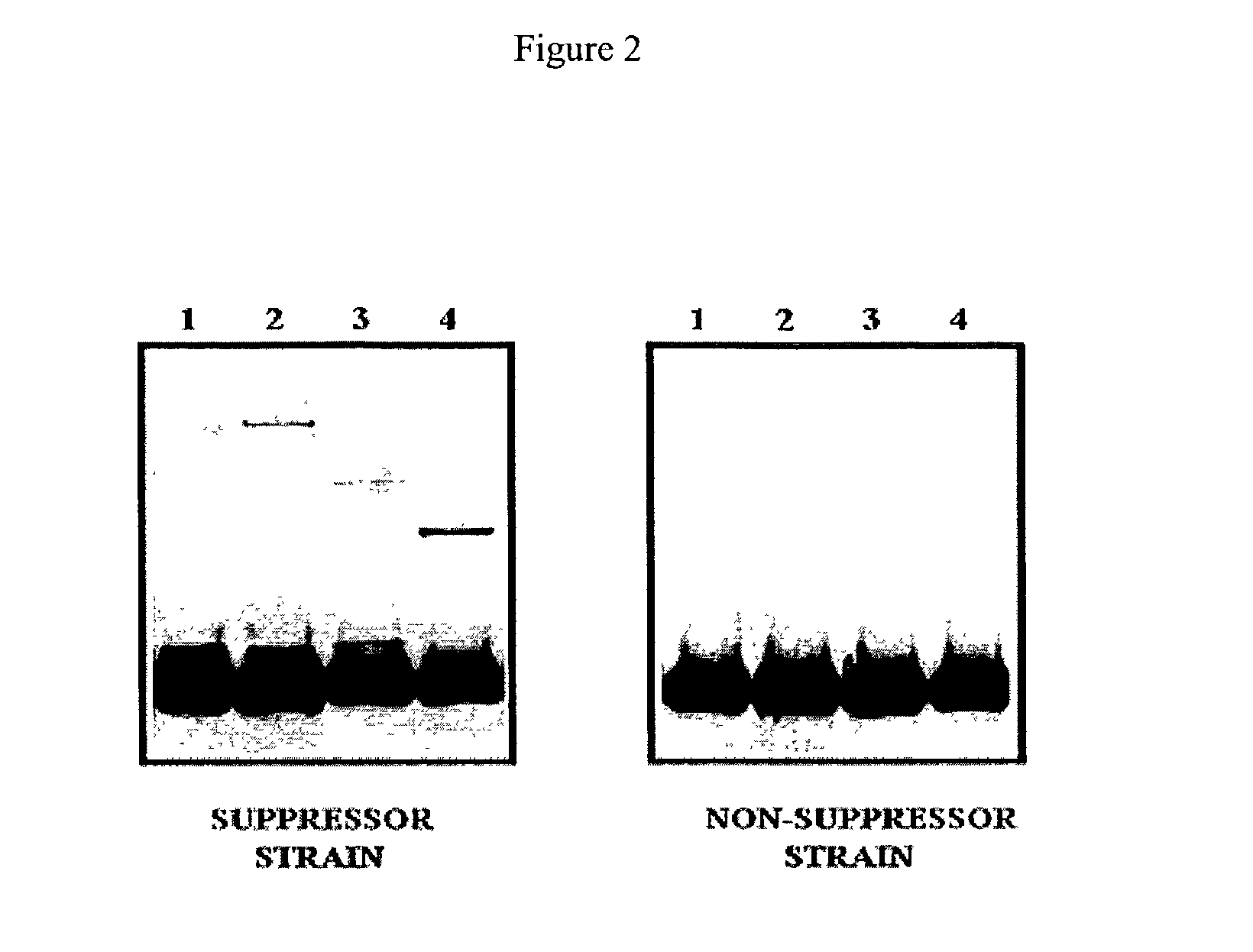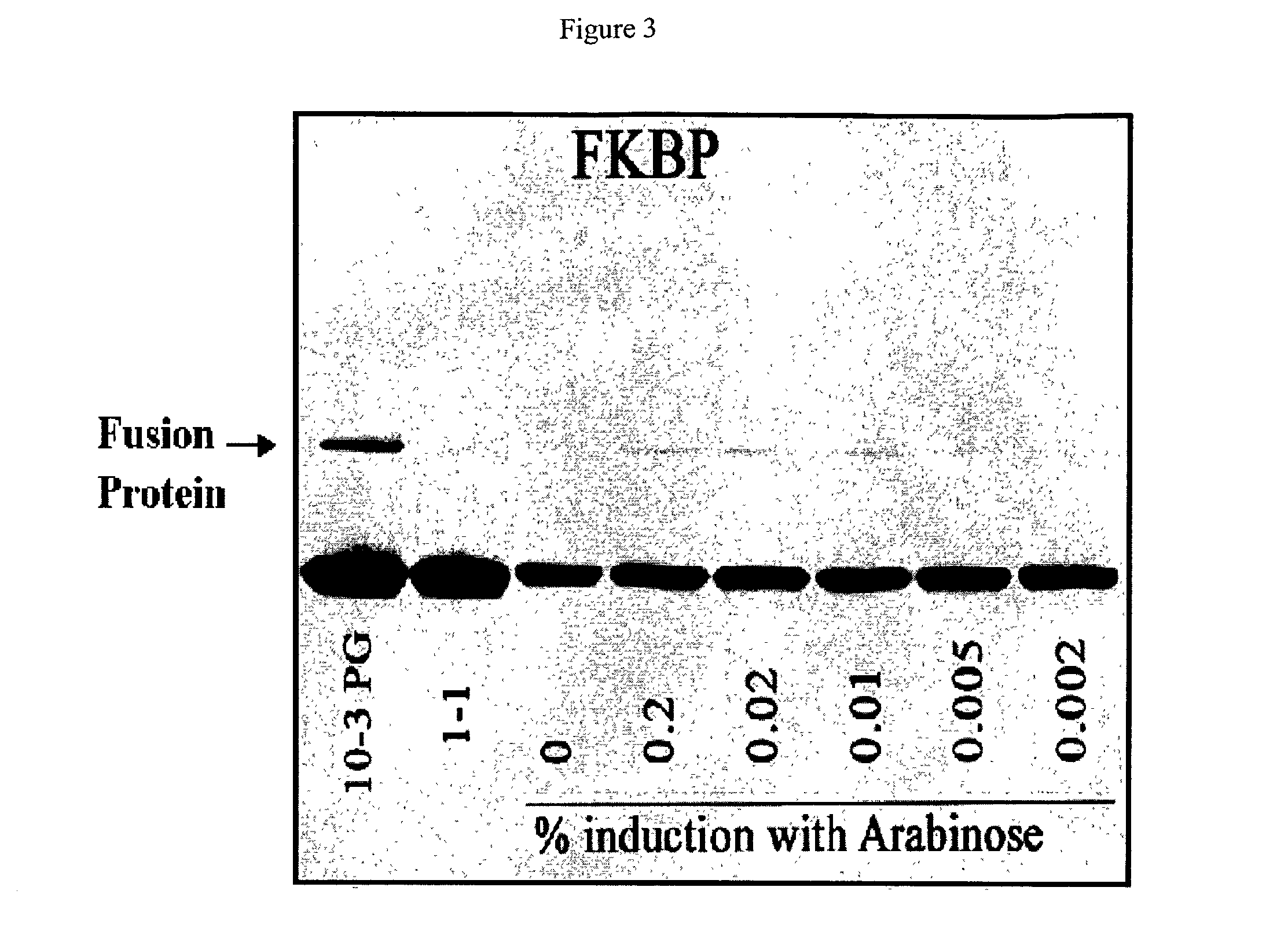Uncoupling of DNA insert propagation and expression of protein for phage display
a phage and protein technology, applied in the field of uncoupling of dna insert propagation and expression of protein for phage display, can solve the problem that the approach does not fully address a second difficulty, interference with the phage life cycle,
- Summary
- Abstract
- Description
- Claims
- Application Information
AI Technical Summary
Benefits of technology
Problems solved by technology
Method used
Image
Examples
example 1
Phage Constructs and Cell Lines
[0057]Using T7 as a representative example, a phage display construct derived from the T7 genome has been constructed in accord with the present invention. The complete sequence of the T7 genome is known in the art. The construct has the coat protein encoded by gene 10 under the control of a wildtype T7 promoter (comprising TAATACGACTCACTATA (SEQ ID NO: 1)) and Shine-Delgarno ribosome entry site (comprising GAAGGAGA). Both these sequences are upstream (5′) of the ATG start codon of gene 10, which has been modified at its 3′ end to contain restriction sites to readily permit fusion with a sequence encoding a heterologous polypeptide as described above and herein. This construct has been termed the “ATV” phage or ATV phage construct.
[0058]In alternative embodiments of the invention the T7 promoter may be deleted and / or the Shine-Delgarno sequences may be mutated to reduce the level of expression from gene 10 (whether alone or as a fusion with a sequence ...
example 2
Induction of Phase Display by Amber Suppression
[0062]Two different cDNA sequences were inserted into the ATV phage constructs containing the amber codon. The cDNAs encode the FK506 binding protein (FKBP) and the p38 mitogen activated protein (MAP) kinase (MAPK). BL21 cells containing pBAD-tRNAAla / TAG were grown to log phase and induced for 30 minutes with two different concentration s of L-arabinose to cause expression of the suppressor tRNAAla / TAG. After induction, the cells were infected with ATV phage that contain cDNA inserts that encode either FKBP or p38 MAPK as a fusion with the gene 10 coat protein. The results of a Western blot of the resultant phage proteins are shown in FIG. 1, which clearly indicates that there is little or no detectable expression of the fusion protein in the absence of L-arabinose. The addition of L-arabinose at the two concentrations used increases expression of the fusion protein in an arabinose concentration dependent manner.
[0063]Similar results ar...
example 3
Dependence of Suppressor Activity on Arabinose Concentration
[0064]The ATV-FKBP phage was used to infect BL21 cells grown to log phase and induced for 30 minutes with five different concentrations of L-arabinose (from 0.2% to 0.002%, final concentrations). In the same experiment, the level of fusion protein expression was compared to Novagen's T7 10-3 strain (high expressor) and T7 1-1 (low expressor) phage strains containing the same FKBP cDNA. The results of a Western blot analysis of the phage proteins are shown in FIG. 3, which shows that the amount of fusion protein produced is increased by increasing amounts of L-arabinose used for induction. The observed level of fusion protein produced in the ATV strain is higher than that observed for T7 1-1 but lower than that for T7 10-3 phage. Further increases in the expression with the ATV strain can be seen by reducing the amount of glucose in the medium of the cells. Lower glucose levels allow greater induction of the BAD promoter.
PUM
| Property | Measurement | Unit |
|---|---|---|
| Electrical resistance | aaaaa | aaaaa |
Abstract
Description
Claims
Application Information
 Login to View More
Login to View More - R&D
- Intellectual Property
- Life Sciences
- Materials
- Tech Scout
- Unparalleled Data Quality
- Higher Quality Content
- 60% Fewer Hallucinations
Browse by: Latest US Patents, China's latest patents, Technical Efficacy Thesaurus, Application Domain, Technology Topic, Popular Technical Reports.
© 2025 PatSnap. All rights reserved.Legal|Privacy policy|Modern Slavery Act Transparency Statement|Sitemap|About US| Contact US: help@patsnap.com



